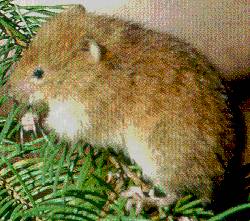| Tree voles | |
|---|---|
 | |
| Red tree vole, (Arborimus longicaudus) | |
| Scientific classification | |
| Kingdom: | Animalia |
| Phylum: | Chordata |
| Class: | Mammalia |
| Order: | Rodentia |
| Family: | Cricetidae |
| Subfamily: | Arvicolinae |
| Tribe: | Phenacomyini |
| Genus: | Arborimus Taylor, 1915 |
| Type species | |
| Phenacomys longicaudus True, 1890 | |
| Species | |
The genus Arborimus is a group of voles found in western North America. The genus name is Latin for "tree mouse". Some sources include this genus with the heather voles, genus Phenacomys, and both are classified in the tribe Phenacomyini. [1]
These animals live in forested areas and two species live in trees. They are small rodents with short ears and long legs. They are primarily herbivorous. Predators include owls and mustelids.
Species in this genus are notable for their extremely unusual life history; females have an arboreal lifestyle, living up to 30 meters above the ground in trees, while males (despite being capable of climbing) burrow underground or live in piles of vegetation. They live apart for most of the year aside from during the breeding season, when males climb the trees to mate with the females and build nests. Following the breeding season, males climb back to the ground, leaving the females to rear the offspring in the trees. [2] [3] [4]







